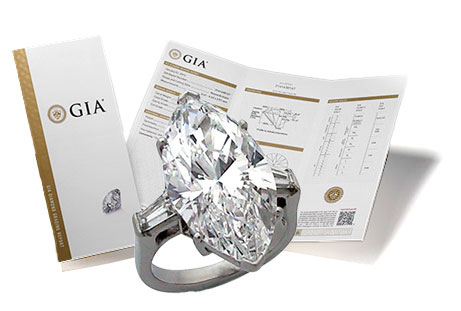Verifying the Lab Report
 Every piece of diamond jewelry of substantial value should have a report from a reputable grading lab.
Every piece of diamond jewelry of substantial value should have a report from a reputable grading lab.
Once you have that, it's critical not to skip the next step:
Check the report number.
Grading labs with the highest reputations are listed below. Here's a look at the importance of using their verification services.
One insurer received a submission with an appraisal that included a GIA report number. The underwriter used GIA's online Report Check but found no such number. The underwriter followed up with a phone call to GIA and got this information:
- GIA's Report Check lists only reports done after 2000. For earlier reports, you can call GIA to check its database.
- The GIA database is complete.
- There is no key to recognizing a valid GIA number, as the system has changed over time. You must check with GIA.
- There is no way to access or validate a report except by its number. Describing the stone or naming the owner will not be of use.
- Sometimes the report number is inscribed on the stone but, depending on the report, inscription may be optional and come at additional cost. (GIA offers a number of reports, at different price points, with more or less information.)
- The layout of reports has changed over time, so how the report looks is not a reliable indication of its authenticity.
- The GIA representative also mentioned that sometimes a person simply mistakes some other report for a GIA report.
This submission involved a report from GIA, but much of the info above is true for other labs as well.
In any case, if the appraisal mentions a lab report but the report was not in the submission, ask the insured for a copy. Then, verify the report.
A recent scam involved using the impressive name and logo of an established organization, but it was a membership organization for appraisers, not a grading lab at all. Insurers who did not bother to verify the report would never know they (and the insured!) had been scammed.
If there is no report number, or no way to verify the report, you probably have a document from a bogus entity with no reputation, no expertise, no grading lab.
Quick step to avoid fraud
Once you have the report, and have verified its number, just check to be sure the report is for the stone you are insuring. Since you should also have an appraisal from a qualified appraiser independent of the seller, check that the carat weight, color and clarity on the lab report match what's on the appraisal.
Since valid reports from reliable labs are available on the internet, fraud-minded buyers can casually match them up with lower-quality stones or even fake gems. The report number will check out, but the gem description won't match. Scammers count on customers and insurers not reading the reports or even knowing what to look for.
Don't be taken in by the alphabet soup of certs out there, many from disreputable or bogus labs. We recommend relying on the respected gem grading labs listed here. You can use the links to verify reports you receive.
Reliable Labs
Gemological Institute of America GIA Report Check
American Gem Society Lab AGS Report Verification
Gem Certification and Assurance Lab GCAL Certificate Search
FOR AGENTS & UNDERWRITERS
Always verify lab reports.
Don't take at face value just any document that calls itself a diamond report. The market is flooded with bogus certificates from less reliable labs and even from non-existent labs.
Any certificate you accept may be the basis for a future settlement, so you want to be sure the certificate is reliable.
Be wary of a diamond report if:
- It comes from a lab other than one of the reliable labs noted above.
Ask for a report from a reliable lab.
- It is supplied by the retailer.
If it's from a reliable lab, be sure to verify. If from some other lab, consider asking for a report from one of the respected labs.
- It carries a valuation.
This certificate is a sales tool (and a big red flag), since respected labs only describe the stone, they don't give market value. Consider getting a report from a reliable lab.
- The jewelry was bought on the internet, from a shopping network, or while traveling abroad, and it came with a diamond report.
These sources are notorious for supplying inflated lab reports. Be sure to get a report from a reliable lab.
Even a reliable lab report is not a substitute for an appraisal. The lab report describes only the stone; an appraisal describes the jewelry as a whole, including metal type, karatage, weight, trademark, etc., and gives current valuation.
Ideally the appraisal should be on JISO 78/79, prepared by a qualified gemologist (GG, FGA+, or equivalent), preferably one who has additional insurance appraisal training. One course offering such additional training is the Certified Insurance Appraiser™ (CIA) course of the Jewelry Insurance Appraisal Institute.
FOR ADJUSTERS
Compare data on all documents — appraisals, diamond reports, and sales receipt — to be sure the information agrees.
If you have a report from one of the reliable labs, hopefully it was verified and you can trust it.
If there is only a report from a lab not listed above, compare the report's description with the description on the appraisal. Compare the valuation with the purchase price, if available.
©2000-2025, JCRS Inland Marine Solutions, Inc. All Rights Reserved. www.jcrs.com

